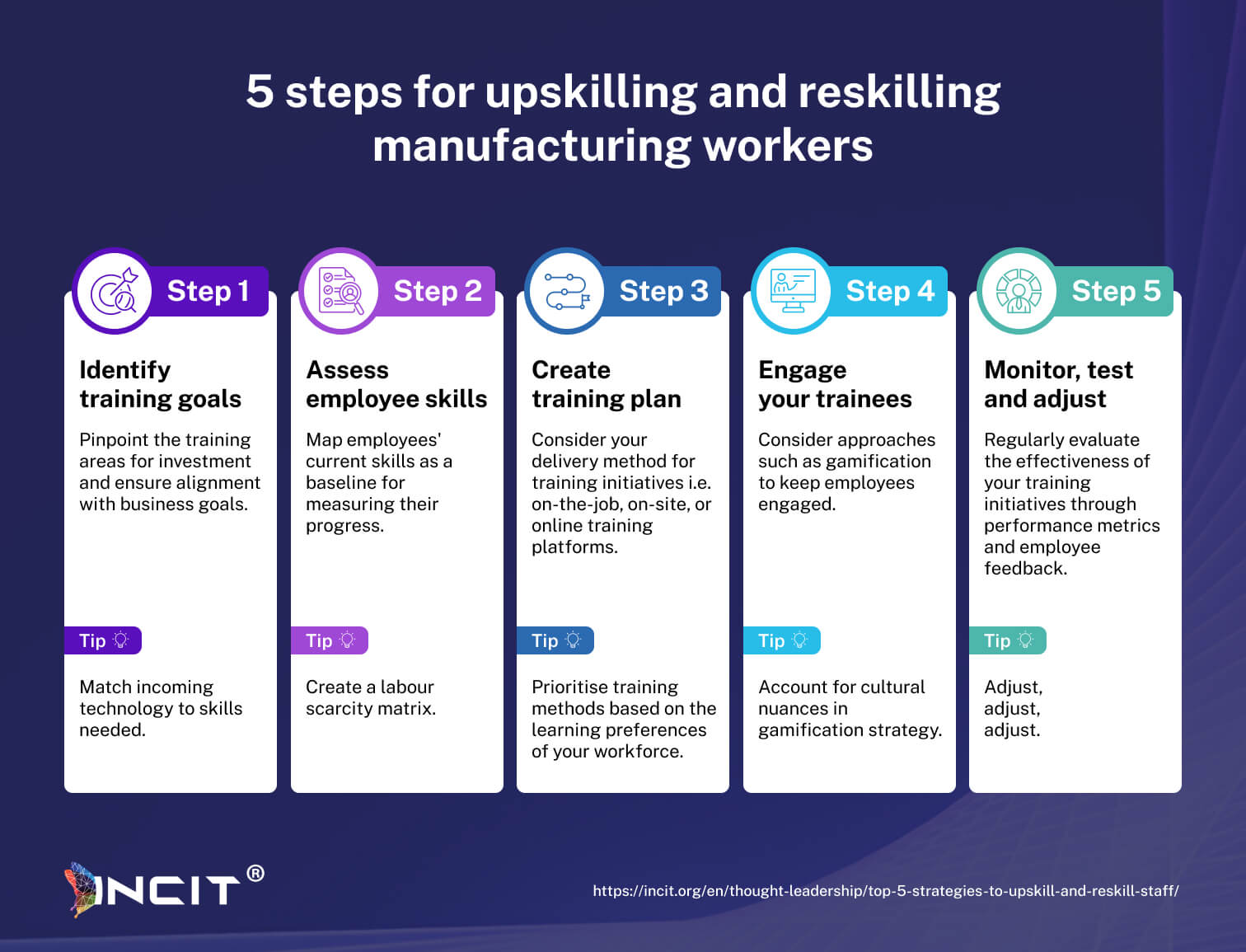Các khoảng cách kỹ năng đáng kể trong sản xuất tiếp tục gia tăng, như được nhấn mạnh bởi nghiên cứu của Deloitte, phát hiện ra rằng 2,1 triệu việc làm không được lấp đầy sẽ dẫn đến chi phí khoảng $1 nghìn tỷ cho Hoa Kỳ vào năm 2030 một mình. Chúng tôi biết có nhiều lý do dẫn đến tình trạng thiếu hụt nhân tài hiện tại và tương lai, chủ yếu là do lực lượng lao động già hóa, tiến bộ công nghệ với bộ kỹ năng không theo kịp và quan điểm lỗi thời về vai trò trong sản xuất gợi nhớ đến những điều kiện làm việc nguy hiểm, không hấp dẫn được mô tả trong “The Jungle” của nhà văn người Mỹ Upton Sinclair.
Theo như Phòng Thương mại Hoa Kỳ, 45 phần trăm số việc làm trong ngành sản xuất vẫn chưa được đáp ứng. Diễn đàn Kinh tế Thế giới về Tương lai của Việc làm năm 2023 báo cáo nhấn mạnh rằng 40 trong số các yêu cầu về kỹ năng hiện tại trong sản xuất tiên tiến dự kiến sẽ phát triển trong năm năm tới. Các nhà lãnh đạo đã gióng lên hồi chuông cảnh báo, theo một cuộc khảo sát của Hiệp hội các nhà sản xuất quốc gia (NAM)gần 75 phần trăm nhà quản lý sản xuất cho biết tình trạng thiếu hụt lao động có tay nghề là thách thức kinh doanh chính của họ.
Các nhà sản xuất đang vật lộn với tình trạng thiếu hụt lao động đáng kể đòi hỏi sự quan tâm khẩn cấp, nhưng các doanh nghiệp có thể làm gì để chuẩn bị cho cuộc khủng hoảng nhân tài đang rình rập? Dưới đây, chúng tôi khám phá các bước chính để trao quyền cho người lao động thông qua các chương trình nâng cao kỹ năng có mục tiêu, đảm bảo khả năng phục hồi và tăng trưởng khi đối mặt với những thách thức của lực lượng lao động.

Thúc đẩy lực lượng lao động sẵn sàng cho tương lai thông qua các sáng kiến nâng cao kỹ năng chiến lược
Tình trạng thiếu hụt lao động trong lĩnh vực sản xuất hiện đang là vấn đề phổ biến và dự kiến sẽ trở nên tồi tệ hơn. Các công ty sản xuất cần phải đầu tư vào các sáng kiến nâng cao và đào tạo lại kỹ năng. Bằng cách triển khai các chương trình đào tạo có mục tiêu phù hợp với các vai trò công việc đang thay đổi và tận dụng các phương pháp sáng tạo như trò chơi điện tử (sử dụng nó để đào tạo lại kỹ năng hấp dẫn hơn!), các nhà sản xuất có thể trao quyền cho lực lượng lao động của mình để thích nghi, do đó giảm bớt tình trạng thiếu hụt lao động trong doanh nghiệp. Việc áp dụng các chiến lược này không chỉ thu hẹp khoảng cách kỹ năng mà còn định vị các công ty sản xuất để tăng trưởng bền vững và có khả năng cạnh tranh trên thị trường toàn cầu.
Hơn nữa, các chương trình đào tạo chuyên biệt, chẳng hạn như SIRI/COSIRI Chương trình được cung cấp bởi KHUYẾN KHÍCH, có thể hỗ trợ các nhà lãnh đạo trong quá trình phát triển kỹ năng liên tục của họ bằng chứng nhận này, thúc đẩy các hoạt động số hóa và bền vững trong sản xuất. Việc áp dụng các chiến lược này không chỉ thu hẹp khoảng cách kỹ năng mà còn định vị các công ty sản xuất để tăng trưởng bền vững và cạnh tranh trên thị trường toàn cầu.
Những câu hỏi thường gặp về việc nâng cao và đào tạo lại kỹ năng trong sản xuất
4 chiến lược nâng cao và đào tạo lại kỹ năng là gì?
Bốn chiến lược chính để nâng cao và đào tạo lại kỹ năng trong sản xuất là:
- Đào tạo tại nơi làm việc
- Nền tảng học tập kỹ thuật số
- Quan hệ đối tác giữa ngành công nghiệp và học viện
- Chương trình chứng nhận
Những cách tiếp cận này giúp người lao động có được các kỹ năng mới cho sản xuất thông minh và Công nghiệp 4.0.
Tại sao nâng cao kỹ năng lại quan trọng trong sản xuất?
Nâng cao kỹ năng rất quan trọng trong sản xuất vì nó giúp người lao động thích nghi với công nghệ mới, cải thiện năng suất và duy trì khả năng cạnh tranh trong môi trường Công nghiệp 4.0 đang thay đổi nhanh chóng.
Sự khác biệt giữa nâng cao kỹ năng và đào tạo lại kỹ năng trong sản xuất là gì?
Nâng cao kỹ năng có nghĩa là học các kỹ năng mới để phát triển trong vai trò hiện tại, trong khi tái đào tạo liên quan đến việc đào tạo công nhân cho các vai trò hoàn toàn mới. Cả hai đều cần thiết trong sản xuất để hỗ trợ chuyển đổi kỹ thuật số và tự động hóa.
Các nhà sản xuất có thể tạo ra lực lượng lao động sẵn sàng cho tương lai như thế nào?
Các nhà sản xuất có thể tạo ra lực lượng lao động sẵn sàng cho tương lai bằng cách đầu tư vào đào tạo liên tục, áp dụng các công cụ số, xây dựng văn hóa học tập và liên kết phát triển lực lượng lao động với các công nghệ Công nghiệp 4.0.
Các nhà sản xuất phải đối mặt với những thách thức nào trong đào tạo lực lượng lao động?
Các nhà sản xuất phải đối mặt với những thách thức như ngân sách đào tạo hạn chế, thiếu hiểu biết về công nghệ số, lực lượng lao động già hóa và khó theo kịp các công nghệ thay đổi nhanh chóng trong sản xuất thông minh.
Ví dụ về nâng cao kỹ năng trong sản xuất thông minh là gì?
Các ví dụ về nâng cao kỹ năng trong sản xuất thông minh bao gồm đào tạo công nhân sử dụng robot, công cụ phân tích dữ liệu, bản sao kỹ thuật số, nền tảng IoT và hệ thống sản xuất dựa trên AI.
Công nghiệp 4.0 ảnh hưởng đến kế hoạch nguồn nhân lực như thế nào?
Công nghiệp 4.0 tác động đến kế hoạch lực lượng lao động bằng cách chuyển nhu cầu sang các vai trò am hiểu công nghệ, đòi hỏi các kỹ năng mới và thúc đẩy các nhà sản xuất xem xét lại các chiến lược đào tạo, tuyển dụng và giữ chân nhân tài.
Những phương pháp thực hành tốt nhất để chuyển đổi lực lượng lao động trong sản xuất là gì?
Các biện pháp thực hành tốt nhất để chuyển đổi lực lượng lao động bao gồm đánh giá khoảng cách kỹ năng, lộ trình học tập cá nhân hóa, phát triển khả năng lãnh đạo, hợp tác với các nhà cung cấp công nghệ và theo dõi hiệu suất gắn liền với các mục tiêu của Công nghiệp 4.0.


